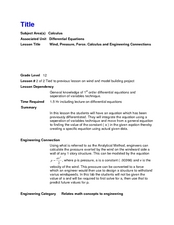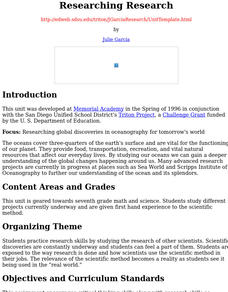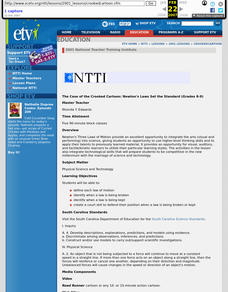Curated OER
Wind, Pressure, Force, Calculus and Engineering Connections
Twelfth graders solve first order differential equations using the separation of variables technique. In this calculus lesson, 12th graders explain the connection between math and engineering. They brainstorm what engineers do in real life.
Curated OER
The Fourth Quadrant of Proportiona
Students experiment with scale to solve a problem presented in a video clip. They determine the correct size to use when constructing a model and evaluate the use of proportions in real life applications.
Curated OER
Your Body's Building Blocks
Students study the elements of the Periodic Table as they relate to the building blocks of the body. They experiment to measure the amount of iron in the body.
Curated OER
Water 2: Disappearing Water
Learners will observe the amount of water in an open container over time and also examine the amount of water in a closed container over time. They then will compare and contrast the sets.
Curated OER
Energy Defined
Fourth graders complete activities to study the sources of energy and forms. In this energy lesson, 4th graders discuss the origin of energy and define it. Students participate in several experiments to further study energy including a...
Curated OER
Breaking News English: Woman Fired for Using Capital Letters
In this English worksheet, students read "Woman Fired for Using Capital Letters," and then respond to 1 essay, 47 fill in the blank, 7 short answer, 20 matching, and 8 true or false questions about the selection.
Curated OER
The Scientists’ Way
Students summarize the steps of the scientific method. In this life science lesson, students explain the importance of varying only one variable at a time. They analyze possible flaws in their experiment.
Curated OER
Water Density and Stability Lab
Students observe how different water densities and salinity control the depth at which different water masses occur. Submarines are used as a case study. This is a well-designed with an excellent worksheet.
Curated OER
Lesson 3: Understanding Population Growth
Students explain population growth in Maryland and its relationship with age structure, household growth and consumption of land.
Curated OER
CHARTING A COURSE
Students model how a gyroscope works with string, an old phonograph record and crayon.
Curated OER
Investigation 6 - Celestial Model
Third graders investigate why stars appear to move across the night sky.
Curated OER
Weather Journals
Students check and record the weather first thing each morning in their weather journals.
Curated OER
Memory Game Art Project
Learners create a memory game featuring the Arctic and, more particularly, the Arctic hare. They examine a few pictures on a website embedded in this plan in order to get an idea of the Arctic landscape and the activities of the Arctic...
Curated OER
Translating Parabolas
High schoolers make informed choices among technology systems, resources, and services. They select and apply technology tools for research, information analysis, problem solving, and decision making in content learning.
Curated OER
When the Lights Go Out!
Students identify coal as the primary fuel used to generate electricity. After discussing coal's use in the generation of electricity, have students complete "When the Light Go Out" worksheet.
Curated OER
Wild Waters Downtown
Fourth graders investigate how wild animals living in urba settings also need sources of clean water. They discuss the open water issues of West Nile Virus and what happens to urba animals as these poolings area are cleaned up. ...
Curated OER
Where My Peeps At?
Students conduct a series of activity that demonstrates Charles' and Boyle's Law. In this chemistry lesson, students determine the relationship among pressure, volume and temperature. They solve problems using mathematical equation.
Curated OER
Researching Researchers
Seventh graders use accessible technology to explore active research projects currently taking place, choose a current research project to study and create a presentation using the information that they have gathered.
Curated OER
The Case of the Crooked Cartoon: Newton's Laws Set the Standard
Students have the opportunity to use higher-level thinking skills and to apply their talents to previously learned material. It provides an opportunity for visual, auditory, and tactile/kinetic learners to utilize their particular...
Curated OER
What's it Like Inside the Sun?
Students perform experiment in which they model convection as it occurs in our Sun. They also explain that convection acts where the effect of gravity and heat are present (low density fluids can rise and cool, and high density fluids...
Curated OER
Discussion Questions about Human Nature
Students explore the different types of heros in American history.
Curated OER
Main Sequence Stars: A System in Equilibrium?
Fourth graders study the equilibrium of internal forces in a main sequence star.
Curated OER
Cavern Life
Students describe elements and conditions that effect cavern life. They explain the three cavern zones and the differences of each zone. They perform various activities based on grade level.
Curated OER
Beach Zonation
Students identify and separate the different zones of the beach by observation. They investigate beach zonation by gathering and comparing sand samples gathered from different areas of the beach.

























